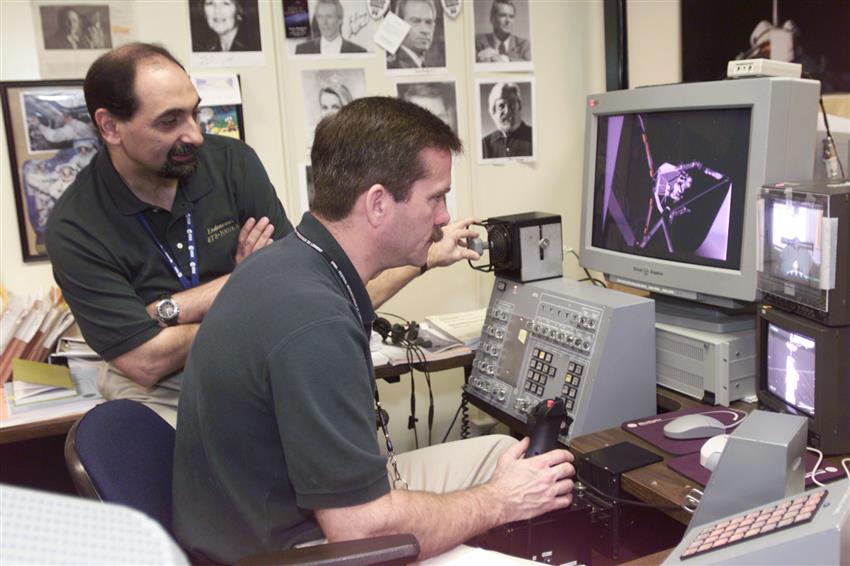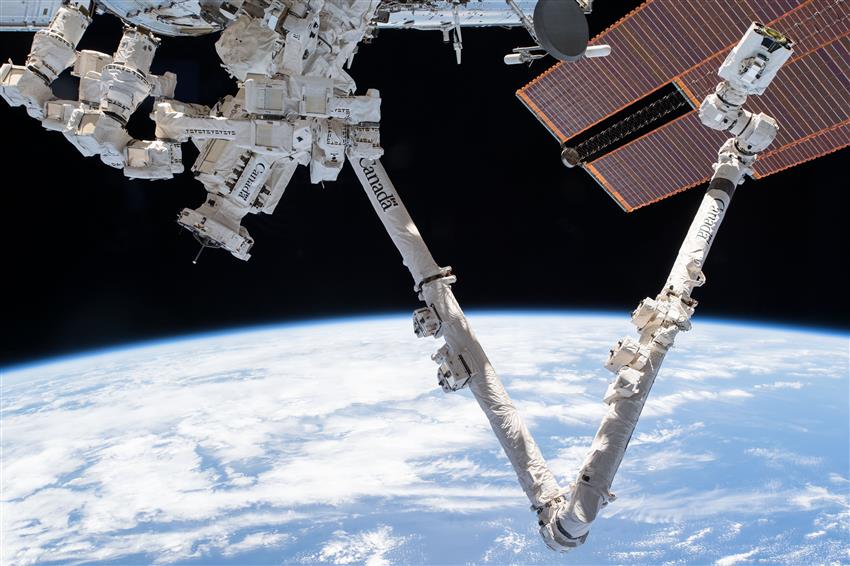The history of Canadarm2
Canadarm2 made its debut on board the International Space Station (ISS) in . The Canadian robotic arm is an improved version of the original Canadarm, which worked on NASA's fleet of Space Shuttles for 30 years (-).
Here is an overview of the famous robotic arm's journey, from design to deployment.
Design and assembly
Canadarm2 was designed, built, and tested from to by MDA in Brampton, Ontario.
The second-generation arm was designed to feature:
- increased size and durability
- the ability to handle much larger payloads
- innovative end-over-end mobility
Sending anything to space is complex, but Canadarm2's destination presented a new challenge. Since the robot was not going to return to Earth for refurbishing or maintenance, all of its parts had to be replaceable in space.
Preparation and delivery
Before leaving Earth on its one-way trip to space on , Canadarm2 was safely secured or "bolted" to a custom metal pallet designed to keep the arm intact during transportation. The pallet was loaded into NASA Space Shuttle Endeavour's payload bay.
In the meantime, other preparations were also made to ensure a smooth delivery. Canadian Space Agency (CSA) astronaut Chris Hadfield was one of the two crew members assigned to unpack and set up Canadarm2 on the Station.
History was about to be made: Hadfield would become the first Canadian to ever perform a spacewalk.
To ensure a flawless installation and prepare for technical activities, Hadfield and NASA astronaut Scott Parazynski participated in intensive training.
Both practised tasks underwater at NASA's Neutral Buoyancy Laboratory, in the 12-metre-deep pool designed to simulate the weightlessness of space.
Hadfield also learned to operate the Shuttle's Canadarm through hours of training on a robotics simulator. Among other duties, he would be responsible for using the Canadarm to put the pallet back into the Shuttle for return to Earth.
Installation and powering up
Installing Canadarm2 on the Space Station required complex choreography.
Once Endeavour was within range of the ISS, the Canadarm lifted the metal pallet containing Canadarm2 from the Shuttle's cargo bay to attach it to the ISS's Destiny laboratory.
Spacewalkers Hadfield and Parazynski then:
- attached a temporary cable to supply electrical power, data, and video between Canadarm2 and the Station
- unbolted the arm from the pallet
- manually unfolded its two long booms
- secured the hinges in the middle that had allowed the booms to be bent in two
From inside the Station, NASA astronauts Susan Helms and Jim Voss remotely commanded Canadarm2 to reach out with one of its two "hands." Canadarm2 attached itself to a power data grapple fixture on the Destiny module. The arm released itself from the pallet, marking its first manoeuvre in space.
A historic robotic handshake
On , Canada's famous robotic arms accomplished a task together and engaged in the first "robotic handshake" in space history.
The Canadian arms collaborated to place the metal transportation pallet in Endeavour's cargo bay for return to Earth:
- Canadarm2 removed the pallet from its storage location on the ISS and "passed" it to the Canadarm.
- From inside the Shuttle, Chris Hadfield used the original arm to grasp it from the ISS's new robotic arm.
- Hadfield placed the pallet in the Shuttle bay, marking the first joint operation between two Canadian robotic arms in space.
Testing and deployment
Following the installation, Canadarm2's basic functions were tested. The arm was able to carry out its activities and help assemble the Space Station.
Canadarm2 assembled the majority of the ISS's components and modules. It has also moved several tonnes of material and supported many astronauts during risky spacewalks.
Currently, the Canadian robotic arm is used to:
- maintain and repair the Station
- relocate Dextre, science experiments, spare parts and even astronauts
- catch and berth unpiloted resupply spacecraft




